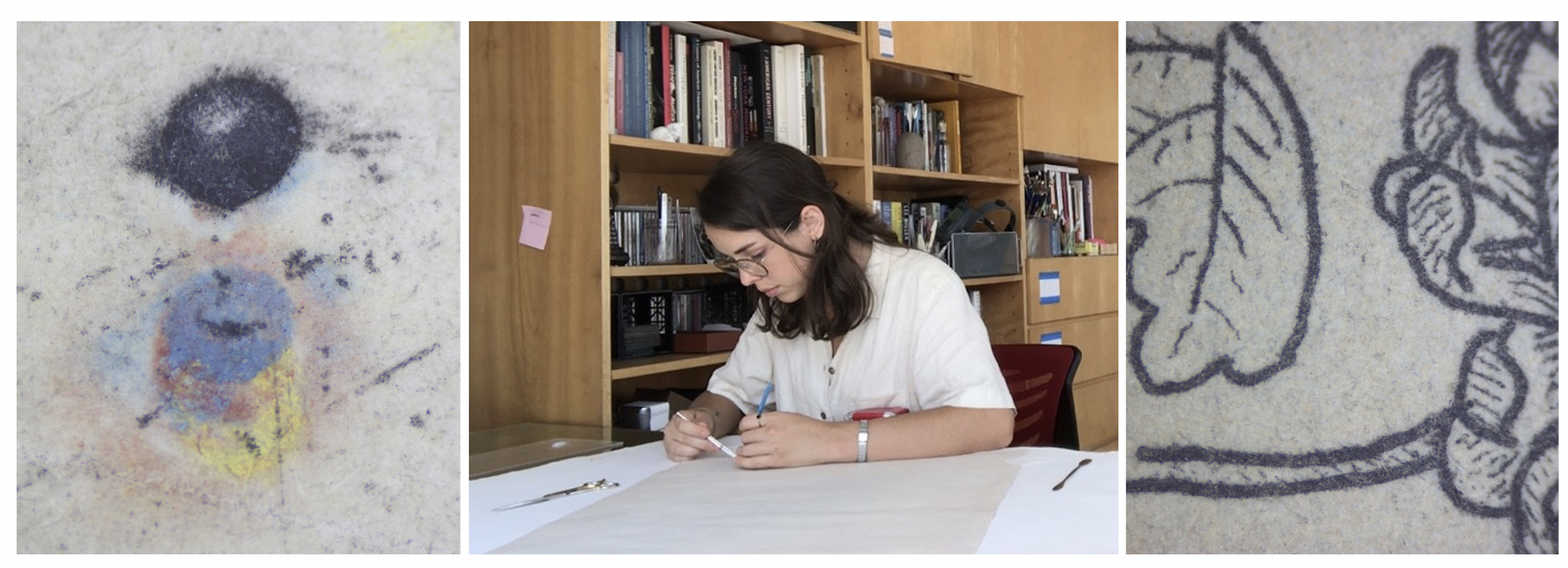Center: Elena mends a paper object at Andrea Pitsch Conservation in New York City. Frame: Microscopic images of details from a print by Felicien Rops (full image below) Left: Registration marks that reveal four colored plates were used to create the image Right: Etching detail from the bottom right corner
A typical family archive could contain numerous works on paper, ranging from old birth certificates to great-grandmother’s beautiful watercolors. Often, these bits of history are tucked away in boxes in the attic or basement, but is this really the best way to preserve our family histories?
As Conservation Interns at the Michael C. Carlos Museum, my colleague Kelyu Yu and I have been tasked with the rehousing of over one hundred works of art on paper by the 19th-century Belgian artist, Felicién Rops. Rops was an experimental printmaker, often using different techniques such as lithography, etching, and heliogravure. He explored challenging subjects such as the nature of the subconscious mind, erotica, and the occult.
These works had been stored in large ring binders with plastic-sleeved black paper pages. These non-archival portfolios contain detrimental acidifying agents like lignin. The lignin in wood pulp papers and portfolio boxes breaks up the long cellulose chains that make up the paper fibers, causing the work to be more brittle and discolored.
Artwork shown: Pornocrates, Felicien Rops, 19th century, etching and aquatint, 2014.010.137, Ex coll. Stuart A. Rose Manuscript, Archives, and Rare Book Library, Emory University
To rehouse these works, we first took inventory of all the sizes and grouped them into three categories: small, medium, and large. We then constructed three boxes from archival, acid-free board, and adhesive. Two boxes were used to house all the large prints and the other was divided into sections for the small and medium-sized prints (left).
We carefully removed each print from the old portfolios and removed any non-archival supports such as backing boards or window mats that were not added by the artist himself. We then placed the prints into their new archival storage boxes. The larger prints were interleaved with acid-free paper, while the medium and small prints were placed in individual acid-free folders labeled with the Museum’s accession numbers for inventory.
When it comes to your own family archive, it is important (and possible!) to treat the paper documents with similar care. Check out our recommendations for your collection below:
Artwork shown: Quatre petits poems libertins or L’examen de Flora, Felicien Rops, 1864, etching, drypoint, and aquatint, 2014.010.077, Ex coll. Stuart A. Rose Manuscript, Archives, and Rare Book Library, Emory University
Things to avoid:
- Do not use non-archival housing materials. Non-archival mats and albums contain acids that will discolor the paper and break down the long cellulose fibers in the paper, causing it to become weak and brittle.
- Avoid keeping your works on paper in direct sunlight for long periods of time. Ultraviolet radiation is the most damaging and light exposure is cumulative. Light will cause the image to fade and lose its legibility over time; this sort of damage is irreversible. Don’t store works on paper in areas that are not climate controlled, such as the basement or attic. These places may have a high relative humidity, which can cause paper to warp, promotes mold, and attract insects. High temperatures can accelerate deterioration reactions.
- Avoid dust and insects. In addition to causing discoloration, dust and debris can promote insect infestations. Some insects eat paper and adhesives; others leave droppings, nests, etc.
Things to do:
- Protect your works with folders, boxes, mats, or frames. Use archival, acid-free, or buffered housing materials that are pH 7 or above.
- Reduce the amount of damaging UV radiation that your work encounters by installing drapes over windows and/ or replacing incandescent or fluorescent light bulbs with tungsten or LED. Cumulative light exposure can be further reduced by rotating the works off display every 3 to 6 months or annually.
- As much as possible, keep the temperature between 60° and 70° Fahrenheit and a relative humidity between 45% and 55%, avoiding dramatic swings or cycling between extremes.
- Practice good housekeeping, even in less often accessed storage locations.





